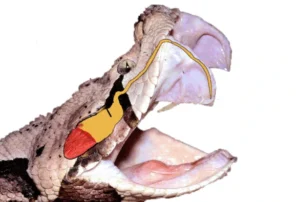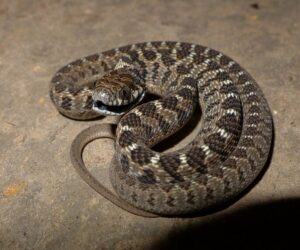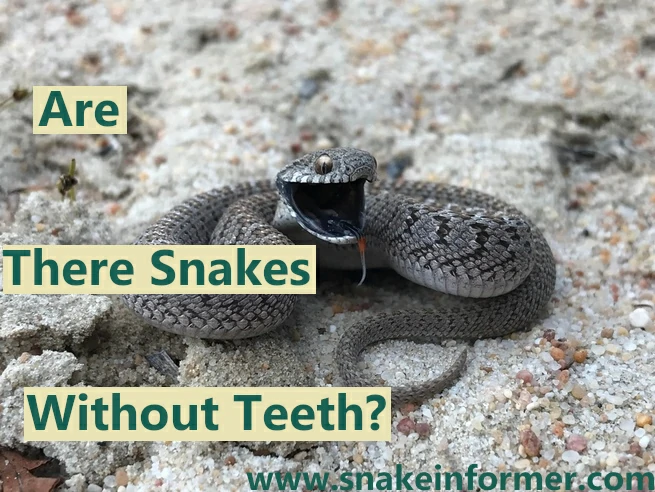Most snakes have teeth which they use to firmly grip prey, and prevent it from escaping. Venomous snakes also have fangs in addition to teeth. They use these fangs to inject venom into prey before it is swallowed.
While most snakes have visible teeth in the mouth, African egg eating snakes (Dasypeltis) have no visible teeth at all. These snakes exclusively feed on birds’ eggs, which means they have no use for teeth like other snakes do.
When egg-eating snakes swallow an egg, they crush the shell with their powerful neck muscles.
They then swallow the contents and regurgitate the crushed shell.
Most Snakes Have Visible Teeth
All snakes have teeth of some kind. Whether they are small or large, venomous or nonvenomous, aquatic or terrestrial, every snake species has them.

These teeth help snakes to catch and maintain a grip on their prey as they swallow it whole.
These teeth are crucial for a snake’s survival. They help the snake catch, subdue, and eat its prey.
That said, it’s important to note that not all snakes have the same type of teeth.
The type of teeth a snake has can vary across different species.
Non-venomous Snakes Often Have Uniform Teeth
In general, most non-venomous snakes (for example, corn snakes, and pythons) have non-grooved, uniform teeth that are gently curved backward (recurved).
These teeth are found on both the upper and lower jaws, often along the palatine bones in the roof of the mouth.
Their function is to firmly hold onto prey to prevent it from escaping and guide it down the throat when it is swallowed.
Venomous Snakes Have Fangs in Addition to Teeth
Venomous snakes (for example, rattlesnakes) have fangs in addition to teeth. These fangs are located on the upper jawbone.

They use their fangs like needles, to inject venom when they bite prey or defend themselves from attackers.
In most species, the fangs fold back into the roof of the mouth when they are not in use.
Unlike we humans who only replace our teeth once in our life, snakes replace their teeth and fangs continually throughout their lives. Behind each tooth, there is a replacement tooth growing and ready to replace the active tooth when needed.
African Egg Eating Snakes Do Not Have Visible Teeth
There are no snakes that do not have teeth entirely.
However, the snakes that come closest to being “toothless” are the African eat-eating snakes (Dasypeltis).
These snakes exclusively eat birds’ eggs, and often raid nests in trees and shrubs to find eggs.
African egg eaters do not have functional teeth at the front of their upper and lower jaws.

This prevents them from accidentally cracking fragile eggs while they eat.
However, they still have small, sharp, tooth-like bones located in their throat known as “hypapophyses.”
When one of these snakes swallows an egg, the egg goes down the esophagus until it hits the hypapophyses.
The snake then tightens its powerful neck muscles, pushing the egg against the bonny projections.
Once the egg is cracked, the snake swallows the contents and then spits out the empty shell.
This method of eating eggs is unique, making egg-eating snakes some of the most specialized feeders in the snake world.
All Snakes Need Teeth to Survive
All snake species need their teeth to survive and thrive. If a snake somehow lost its teeth and was unable to replace them, it would not survive for very long.
Their teeth are specialized tools that help them do many things, such as:
- Holding Onto Prey
The main job of a snake’s teeth is to hold and secure prey when it is captured.
The curved shape ensures the prey stays in place, lowering the chances of the animal getting away.
Non-venomous snakes tend to use their teeth to hold prey firmly, while they wrap their bodies around it, to cause suffocation.
Venomous snakes, on the other hand, use their fangs to bite down firmly into the prey to inject venom.
They rely on the venom to immobilize the prey before it is swallowed whole.
- Assistance in Swallowing
When the prey is immobilized, a snake’s teeth help guide it down the throat.
Snakes have several rows of teeth, especially in the upper jaw, all facing backward.
These teeth act like barbed rails, helping the snake slowly “walk” the prey deeper into its throat.
The upper and lower jaws move alternately, gripping and pushing the prey forward.
This allows snakes to swallow prey whole, even if it is wider than their head.
Even eat eating snakes that lack visible teeth, still need the teeth-like projections in the throat, to swallow eggs whole.
- Self-Defense
Snakes use their teeth to help defend them when threatened by predators (including humans).
When a snake is agitated, it will attempt to bite the attacker, even if it’s not venomous.
Large non-venomous snakes like boas or pythons, can deliver a very painful bite, even without venom.
Defensive bites are usually shallow and are meant to warn rather the attacker, rather than to cause harm.
Snakes Regularly Shed, and Replace Their Teeth
Snakes shed, and replace their teeth (including fangs) many times throughout their lives.
Unlike humans and most mammals, who only regrow our teeth once, snakes continually replace their teeth.
This ensures they always have a functional set of teeth for feeding and defense.
Inside a snake’s jaw, there are several teeth, in different stages of development, lined up behind each functional tooth.
This means that at any given time, a snake has backup teeth, waiting to come into use.
The new teeth can come into action when the old teeth get damaged, or worn down.
That said, it’s important to note that, snakes do not only replace their teeth due to damage or wear.
All the teeth are replaced regularly, like planned maintenance, to keep them functioning at their best.
Think of it like a conveyor belt, where teeth are replaced based on a certain schedule.
Conclusion
Out of more than 4,000 known snake species around the world, there is not even one species that truly does not have teeth.
All snakes have teeth, which they use to capture and swallow prey, as well as to defend themselves.
Although African egg-eating snakes may appear toothless at first, they still have tooth-like structures suited for their diet.
Featured image credit: Willem Van Zyl (CC BY-NC 4.0)
Sources:
Segall M, Houssin C, Delapré A, Cornette R, Herrel A, Milgram J, Shahar R, Dumont M. Armed to the teeth: The underestimated diversity in tooth shape in snakes and its relation to feeding behavior and diet. Ecol Evol. 2023 Apr 13;13(4):e10011. doi: 10.1002/ece3.10011.
Vonk, F., Admiraal, J., Jackson, K. et al. Evolutionary origin and development of snake fangs. Nature 454, 630–633 (2008). https://doi.org/10.1038/nature07178
Krupa, J.J. and Slabach, B.L. (2023), Do African egg-eating snakes (Dasypeltis) exhibit preference for eggs they eat?. J Zool, 320: 292-300. https://doi.org/10.1111/jzo.13073
Hi, my name is Ezra Mushala, i have been interested animals all my life. I am the main author and editor here at snakeinformer.com.

